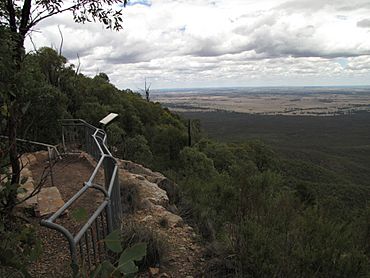Goobang National Park facts for kids
Quick facts for kids Goobang National ParkNew South Wales |
|
|---|---|
|
IUCN Category II (National Park)
|
|

The view south-west from Caloma lookout
|
|
| Nearest town or city | Parkes |
| Established | 22 December 1995 |
| Area | 421 km2 (162.5 sq mi) |
| Managing authorities | New South Wales National Parks and Wildlife Service |
| Website | Goobang National Park |
| See also | Protected areas of New South Wales |
Goobang National Park is a special place in New South Wales, Australia. It's located about 296 kilometers northwest of Sydney. This park protects the biggest remaining forests and woodlands in the central west part of the state. It's unique because plants and animals from both the coast and inland areas meet here.
The area was first called Herveys Range by John Oxley in 1817. Later, in 1897, it became a state forest because its trees were important for timber. Finally, in 1995, it was officially made a national park to protect its natural beauty and wildlife.
Goobang National Park has a camping ground where you can stay overnight. There's also a hiking trail called the Burrabadine Peak Walking Track. It's a moderate hike that's 3.6 kilometers long, going there and back.
Contents
Weather and Seasons
Goobang National Park has a climate that ranges from mild to semi-dry. Summers are hot, with temperatures usually between 17°C and 32°C (63°F and 90°F). Winters are cool, with temperatures from 4°C to 15°C (39°F to 59°F).
The park gets most of its rain in the summer. The eastern side of the park gets more rain, around 645 millimeters (25 inches) each year. The western side gets a bit less, about 564 millimeters (22 inches).
Plants of Goobang
The park is home to 459 different kinds of plants. Some of these plants are very rare and need special protection. For example, the Tylophora linearis plant is listed as vulnerable or endangered. Other rare plants include Eriostemon ericifolius, Astrotricha linearis, Pomaderris queeslandica, and Philotheca ericifoia.
Goobang National Park protects 11 different types of plant communities. Five of these are found only in Goobang. These include woodlands with red stringybark trees on the hills, and areas with red ironbark and black cypress pine trees on sandy soils. There are also unique heathlands and open forests.
Four other plant communities in the park are also very important. These include woodlands with a mix of ironbark, cypress, and gum trees, and woodlands with buloke and white cypress pine trees. You can also find tall open forests in the valleys and shrubby woodlands on the hills.
Animals of Goobang
Goobang National Park is full of amazing animals! There are 31 types of reptiles, 14 types of frogs, and 31 types of mammals living here. You might spot echidnas, wallabies, kangaroos, possums, and different kinds of bats.
Some of the animals in the park are rare or threatened. These include the carpet python, Sloane's froglet, koala, brush-tailed rock-wallaby, grey-headed flying fox, and the New Holland mouse.
Birds of Goobang
Goobang National Park is a great place for birdwatching! Many woodland birds are facing challenges because their forest homes are being cleared. This park helps protect them.
Some of the special birds you might see here include the varied sittella, painted honeyeater, black-chinned honeyeater, regent honeyeater, scarlet robin, flame robin, hooded robin, Gilbert's whistler, diamond firetail, grey-crowned babbler, speckled warbler, brown treecreeper, glossy black cockatoo, superb parrot, little lorikeet, turquoise parrot, spotted harrier, barking owl, black falcon, and little eagle.
Protecting the Park
Wildfires
Fires are a natural part of the Australian bush. To keep the park healthy and diverse, park rangers sometimes do controlled burns. Wildfires can also happen naturally, often caused by lightning during hot, dry summers. Since 1942, there have been 52 wildfires recorded in Goobang National Park.
Threats from Other Animals
Animals that are not native to Australia, like feral cats, foxes, and rabbits, can cause big problems for the park's native wildlife. Feral cats, for example, hunt small mammals and birds, causing their numbers to drop. Rabbits eat young tree seedlings and compete with native animals for food.
Problem Plants
Weeds, like blackberry bushes, can spread quickly and harm the natural environment. They can block creeks, cover up native plants, and provide hiding places for feral animals. Other non-native grasses and plants have also replaced the natural undergrowth in some areas.
Climate Change
Changes in the climate, caused by human activities, can affect the park's plants and animals. Species that need very specific living conditions or can't move easily to new places might struggle. For example, it's thought that many frogs and birds could be affected.
Koalas are especially at risk. They are already facing challenges like habitat loss and diseases. More carbon dioxide in the air can make eucalyptus leaves less nutritious for them. Also, more droughts and bushfires could force koalas to find new homes, putting them in danger from predators and traffic.
See also
 In Spanish: Parque nacional Goobang para niños
In Spanish: Parque nacional Goobang para niños


